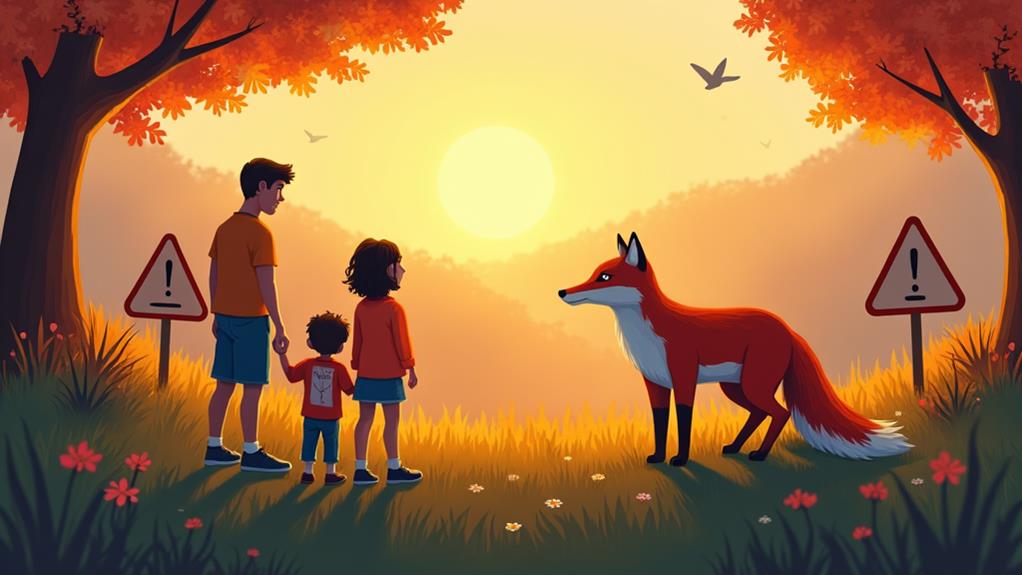Understanding the aggressive behavior of red foxes is crucial for safely coexisting with them. Usually, these clever critters avoid humans and reserve their aggression for food, territory, or potential mates. When they're hungry or feel cornered, their body language, like pinned-back ears and a stiff posture, can signal distress or a defensive stance. And don't be fooled—sometimes playful frolicking looks like aggression! It's essential to keep a safe distance and never feed them, especially since a snack may lure them near. Curious about what more there is to know about these furry neighbors of ours? Stick around for some fascinating insights!
Contents
Overview of Fox Aggression

When it comes to fox aggression, understanding their behavior is key. Most of the time, you'll find foxes skirting around humans, seeing us as no threat at all.
However, when aggression does pop up, it's usually directed at other foxes, especially when it comes to food, territory, or those romantic mating rights. This is particularly evident among species like the Red Fox (the largest true fox species). Imagine a fox with its ears flattened back—this is classic body language signaling that it might feel threatened or protective.
Don't forget that foxes can act defensively if they're cornered or feel hungry. Picture a fox starving in a tight spot; it might just lash out in self-defense!
In rare cases, rabies can change a fox's behavior, leading to more aggressive encounters, but these instances are uncommon. So, if you're out and about, keep an eye on the signs. By understanding their behavior, you can help keep encounters safe and enjoyable for everyone involved, including our furry friends.
When you see any signs of defensive aggression, like flattened ears or a stiff body, keeping your distance is smart. Respect their space, and they'll respect yours!
Causes of Aggressive Behavior
Aggressive behavior in red foxes often stems from various environmental and social pressures. One major factor is food scarcity. When their usual meals are hard to come by, these sly creatures might start eyeing small pets as potential prey, particularly in urban settings where urban adaptation allows higher populations.
It can feel intense, but remember, they're just trying to survive!
Territorial aggression is another common cause, especially among urban foxes. As they adapt to city life, these foxes can become less fearful of humans, leading to more aggressive interactions. They often compete fiercely for resources during mating seasons, and it's not unusual to see males showing off their territorial side.
Sometimes, fear-induced aggression kicks in, especially if a fox feels trapped or threatened. You wouldn't want to be backed into a corner either!
Physical injuries can also influence their behavior. If a fox encounters domestic dogs, for instance, it can worsen their stress and lead to defensive aggression.
Understanding these causes helps you appreciate their behavior a little more. Just like us, foxes have their worries and reasons for acting the way they do. Ignoring their instincts isn't an option—they're just trying to navigate life!
Recognizing Body Language Cues

Recognizing body language cues in red foxes can greatly enhance your understanding of their emotional states. Urban foxes, for instance, exhibit unique behaviors in response to their environments that differ from their rural counterparts.
Watch out for these important signals:
- Ears: If you see their ears pinned back, it might indicate fear or aggression. Those adorable little ears can tell a lot!
- Body posture: A stiff posture, especially when paired with raised fur, suggests your furry friend is uneasy or feels threatened in urban settings where they adapt to human presence 70% of urban foxes thrive.
- Tail position: A high tail position means alertness or potential aggression, whereas a tail curled between the legs signals extreme fear or anxiety.
- Facial expressions: Closed eyes and intense eye contact denote a serious mood, hinting the fox might feel provoked or challenged.
Misinterpretation of Aggression
Misinterpreting aggressive behavior in red foxes often stems from a lack of understanding their complex social interactions.
You might observe two foxes play fighting, their ears flat and mouths wide open, and mistakenly think they're being hostile. In reality, this display can be a friendly, playful encounter within the fox society. It's all about context!
Photographs can also be deceiving. Those snapshots of seemingly aggressive postures? They could just be a yawn or a playful gesture.
Since red fox behavior is filled with nuance, it's essential to learn the non-aggressive indicators, like tail position or how they interact with each other. What looks like a snarl may not be aggressive at all!
Precautionary Measures for Safety

Understanding the nuances of fox behavior is key for ensuring safety when living near them. While these creatures can be intriguing, it's crucial to maintain caution. Here are some precautionary measures to bear in mind:
- No Food Left Out: Don't feed foxes or leave pet food outside. This only encourages them to come closer, which increases the chance of aggressive encounters.
- Secure Enclosures: Make sure your chicken coops and small pet enclosures are fortified. Foxes are clever and might see them as an easy food source.
- Keep Your Distance: If you spot a fox acting aggressively, step back. Contact local animal control to manage the situation safely.
- Provide Escape Routes: If you do encounter a fox, give it a clear path to escape. Cornering can lead to defensive aggression, and we want to avoid that!
Educating yourself about local wildlife behavior helps keep both you and the foxes safe. After all, understanding leads to harmony!
With a little thoughtfulness, you can coexist peacefully with these fascinating animals. And let's be honest; it's always better to appreciate them from a safe distance!
Final Thoughts
Understanding red fox aggression is like peeling an onion—you uncover layers that explain their behavior. By recognizing their body language and the reasons behind their actions, you can navigate encounters safely and with confidence. Remember, not every snarl is a threat; sometimes, it's just a way for them to say, "I'm having a ruff day!" So, whether you're hiking or simply enjoying nature, keep these tips in mind, and let curiosity—rather than fear—guide your adventures.














